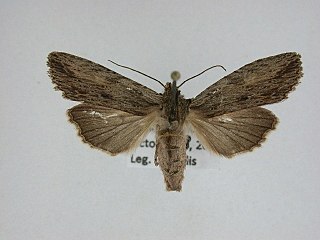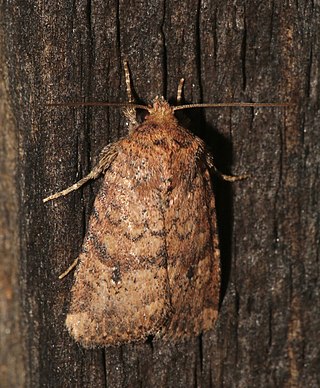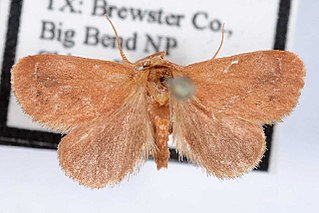Erastria coloraria, the broad-lined erastria, is a species of moth in the family Geometridae, in the superfamily Geometroidea. The species was described by Johan Christian Fabricius in 1798. It is found in North America.
Nemoria rubrifrontaria, the red-fronted emerald, is a species of moth in the family Geometridae, in the superfamily Geometroidea. The species was described by Alpheus Spring Packard in 1873. It is found in North America.
Tarache terminimaculata, the curve-lined bird-dropping moth, is a species of moth in the family Noctuidae. The species was described by Augustus Radcliffe Grote in 1873. It is found in North America.

Helotropha reniformis, the reniform celaena, is a species of moth in the family Noctuidae. The species was described by Augustus Radcliffe Grote in 1874. It is found in North America.

Copablepharon canariana is a species of moth in the family Noctuidae. The species was described by James Halliday McDunnough in 1932. It is found in North America.

Lithophane signosa, the signate pinion or sycamore pinion moth, is a species of moth in the family Noctuidae. The species was described by Francis Walker in 1857. It is found in North America.
Digrammia pallorata is a species of moth in the family Geometridae. It was described by Douglas C. Ferguson in 2008 and is found in North America, where it has been recorded from Utah, Colorado, Nevada, Texas, New Mexico, Arizona and California.
Hydriomena macdunnoughi is a species of moth in the family Geometridae. It was described by Louis W. Swett in 1918 and is found in North America, where it has been recorded from Yukon Territory to western Alberta and Colorado.
Plagiomimicus aureolum is a species of moth in the family Noctuidae. It was described by Henry Edwards in 1882 and is found in North America, where it has been recorded from Arizona, western Texas and New Mexico.

Homorthodes furfurata, the northern scurfy Quaker moth or scurfy Quaker moth, is a species of moth in the family Noctuidae . It was described by Augustus Radcliffe Grote in 1874 and is found in forest habitats in North America. Its range extends across the continent, to south-eastern Canada, Massachusetts, New York, and Mississippi. In the west it ranges south to California, Arizona, New Mexico and Texas.
Parabagrotis cupidissima is a species of moth in the family Noctuidae. It was described by Augustus Radcliffe Grote in 1875 and is found in North America, where it ranges from southern Vancouver Island, along the Pacific Coast states, to southern California. The habitat consists of grasslands and oak woodlands.
Meganola varia is a species of moth in the family Nolidae and superfamily Noctuoidea. The species was first described by William Barnes and Arthur Ward Lindsey in 1921. It is found naturally in North America, where it has been recorded throughout Arizona, New Mexico, and western Texas. While some moths of its species have reportedly been photographed in California, Meganola varia is not found on the California Moth Checklist.

Adoneta gemina is a species of moth in the family Limacodidae, in the superfamily Zygaenoidea. It was described by Harrison Gray Dyar Jr. in 1906 from southern Texas.
Pero radiosaria is a species of moth in the family Geometridae. It was described by George Duryea Hulst in 1886 and is found in North America, where it has been recorded from southern California to Texas.
Parabagrotis insularis is a species of moth in the family Noctuidae. It is found in North America, where it has been recorded from southern Vancouver Island, along the Pacific Coast through California to near the border with Mexico. The species was described by Augustus Radcliffe Grote in 1876.
Matigramma inopinata is a species of moth in the family Erebidae. It is found in North America.
Matigramma obscurior is a species of moth in the family Erebidae. It is found in North America.
Matigramma adoceta is a species of moth in the family Erebidae. It is found in North America.
Matigramma rubrosuffusa is a species of moth in the family Erebidae. It is found in North America.

Matigramma pulverilinea, the dusty lined matigramma, is an owlet moth in the family Erebidae. The species was first described by Augustus Radcliffe Grote in 1872. It is found in North America.






